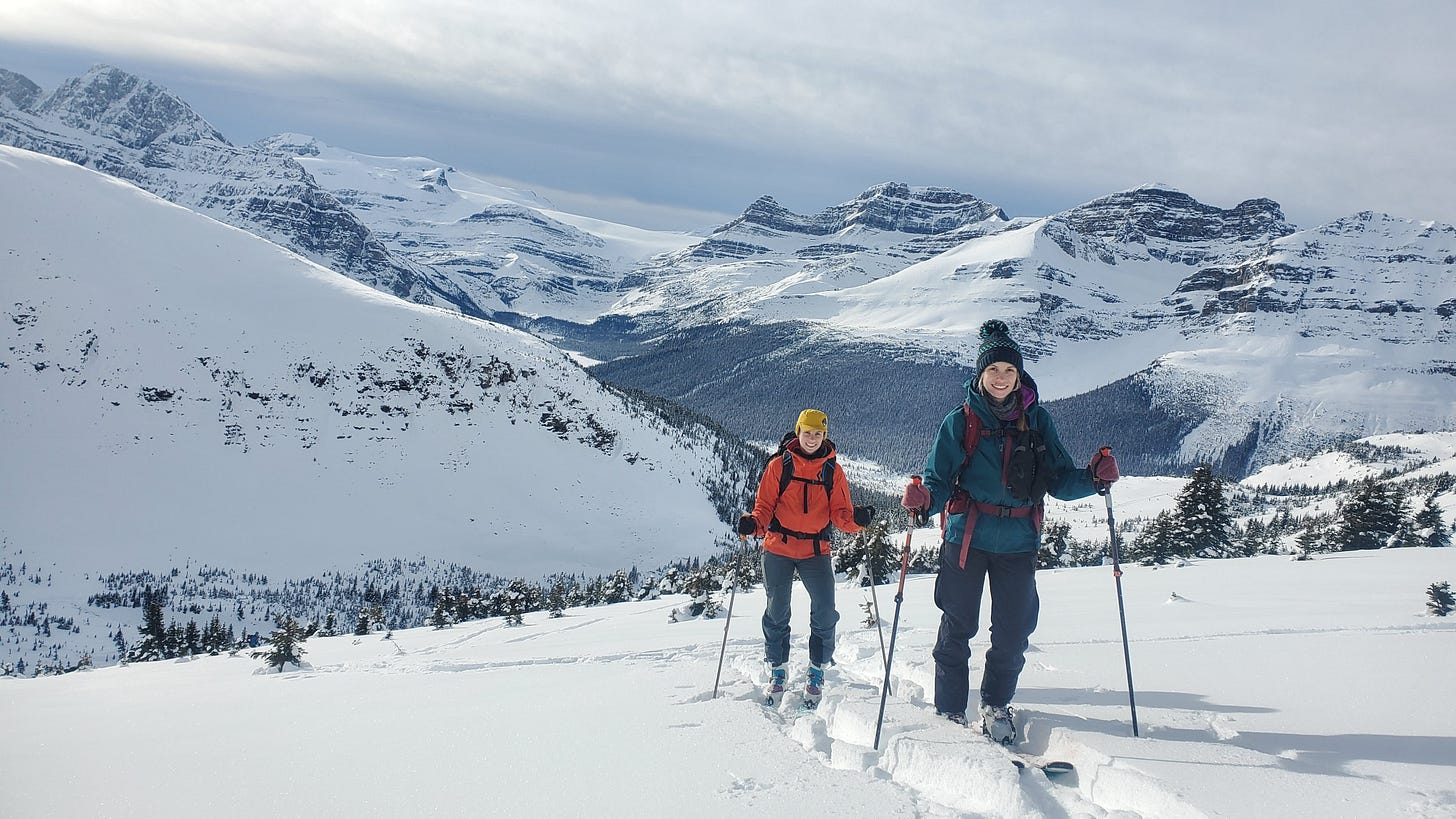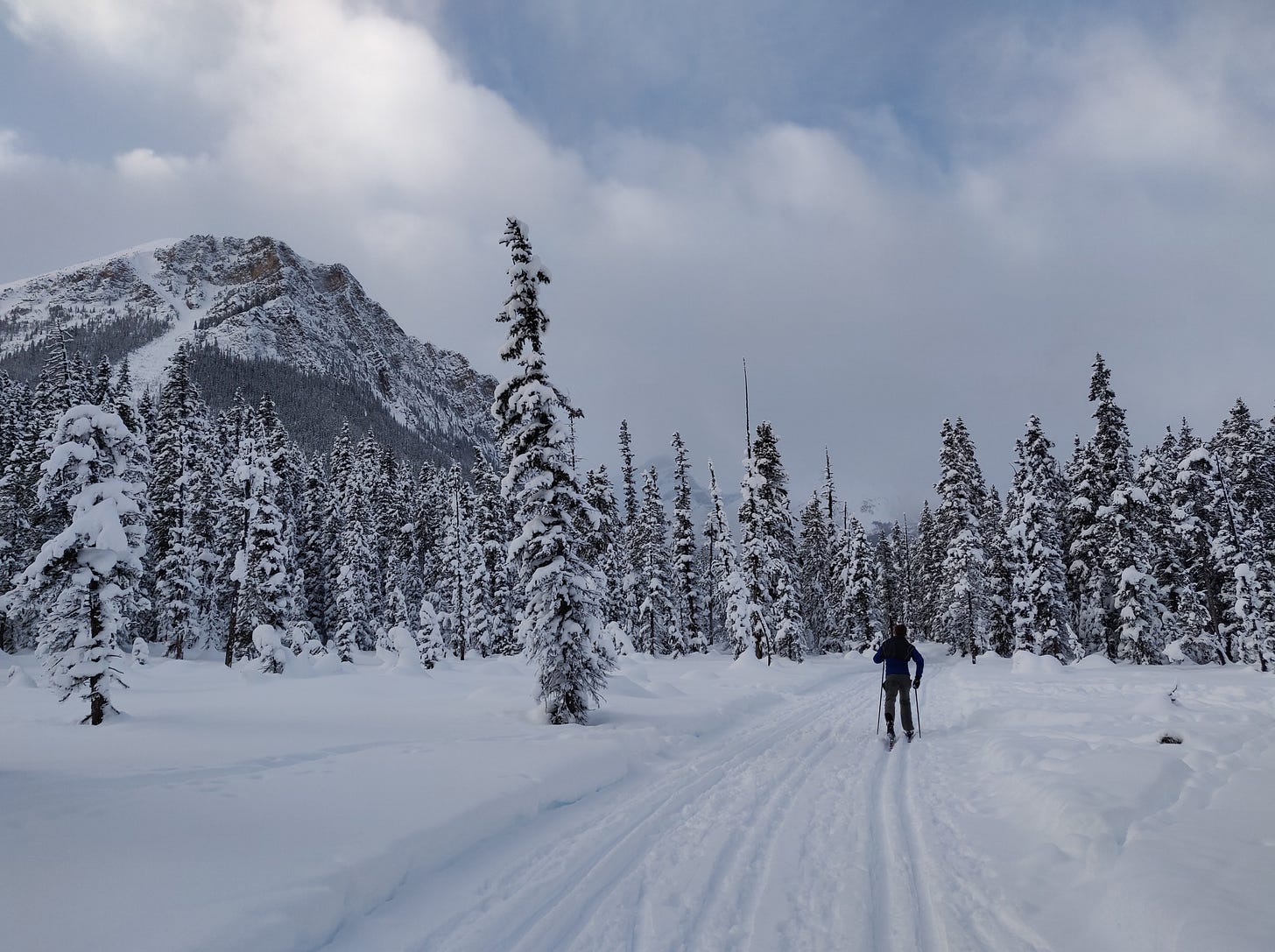Q&A: Layering 101, Preventing Cold Hands & Feet, and Why Cotton is Rotten
From electric socks to the perfect base layers, we answer your questions about staying warm outside in winter
After a relatively balmy start to January across Alberta, cold temperatures are here. That doesn’t mean you have to stay inside. Trust us. We both get cold exceedingly easily and, after years of experimenting with layers, we no longer whine when heading out in temperatures below -20 C. Whether you’re walking the dog, snowshoeing, skiing, biking, skating or running, it really is possible to enjoy being outside in cold weather.
Annalise went backcountry ski touring on Saturday and the temperature was -26C when she started the trek. Hours later, the temperature warmed, the sun shone and many layers were removed.
Two months ago, we shared Three Simple Tips to Stay Warm Outside and since then, we’ve been collecting both your specific staying warm questions, and your tips and tricks. If you have a question after reading this that we didn’t answer, please comment at the end of this post. And, if you’ve got know-how on staying warm, feel free to jump into the comment section with your two cents.
Cailynn on a run last January, when the high hovered around -28C.
What is your number one tip for staying warm outside during winter?
Just one?! Get to know what works and what doesn’t for you. Experiment. Everyone is different. Layering is key and it’s taken both of us time to find clothing that works seamlessly. It didn’t happen after one or two outings. And we’re still learning. Take note of what works and what doesn’t for your body, and in what temperatures and for which activities. Read the following tips, experiment, and come up with a system for staying warm that works for you. Also, as we said in November, bringing a warm drink and changing into dry clothes for the drive home are two easy, life-changing tips that will make your outdoor experiences even better!
Electric socks? Yeah or nay?
We received this question from a reader on Twitter and while neither of us have used electric socks, others have. “Heated socks are insanely expensive and worth every penny, especially when alpine skiing,” an avid adventurer messaged us, adding, “ I avoided them for years. And now it seems so silly. They're magic.” If that’s not a ringing endorsement, we don’t know what is.
What about those hand/foot warmer packets?
We both keep hand and foot warmers in our backpacks when adventuring outside. They’re great to have in case your toes or fingers get too cold. As long as they’re not expired, they tend to warm up fast and they do make a big difference. Rather than waiting for cold ligaments, Annalise tends to use toe warmers preemptively when skiing if the temperature is below -15 C. On Saturday’s -26 C ski tour, Annalise also put hand warmers in her gloves at the beginning of the day and they made a big difference. Another reader told us about authentic Canadian fur warmers, which we’ve never tried, but they come highly recommended and are less wasteful than the disposable warmers.
I keep hearing you’re supposed to layer. What does this mean and why is it so important?
Layering is the key to staying comfortable when moving outside in cold temperatures. The idea behind layering is simple. Wear several layers of clothing instead of one large coat. Several layers means you can add and remove clothing as you get hot or cold and you can de-layer before you get sweaty. Sweating means your clothing will get wet, and when it’s cold out, that’s bad news.
A lot of outdoor enthusiasts like the mantra, “Be bold, start cold.” Wear less layers to start because you’ll warm up as you start moving. Because both of us get so cold so easily, we tend to embrace this mantra at the last possible second. We’ll wear a big outer layer (usually a puffy coat) right up until we start the activity. If we’re with a group that likes to take breaks, we’ll immediately put the big puffy coat back on every time we stop. The second we stop moving, we start to get chilly.
Related to all this is having good communication with the people you’re outside with. Even with that puffy coat on, Cailynn tends to require short breaks and is often the first in a group to want to start moving again. Over time, she’s learned to speak up about this instead of politely waiting and getting really cold.
What are the layers?
The classic layering system is made up of a base layer, mid layer and outer layer. Good, detailed explainers of this system can be found here and here.
What are some tried and true base layers, both tops and bottoms?
Cailynn swears by merino wool base layers — long johns, a long sleeve top and a buff — for pretty much every winter activity she does. (Find more details about merino wool and tips on where to get a deal on it here.) She is also a big fan of vests and finds they work really well to keep her core warm. Annalise typically wears an old pair of MEC Polartec long johns on the bottom and either a zip up merino wool long sleeve or a merino wool tank top and a Polartec polyester and spandex long sleeve on top. It’s important that your base layers are made of materials that wick sweat away, such as polyester or wool. Don’t wear cotton base layers, or as the outdoor mantra goes, “Cotton is Rotten.” Why? Once cotton gets wet, it stays wet and loses its insulating properties, which is dangerous in winter.
Layers are expensive. Do I really need them?
Keep in mind good layers are helpful in all seasons and for all activities and they will last you a very long time. Both of us often wear our base layers on summer backpacking trips and spring and fall hiking and biking trips. The same goes for mid and outer layers. Keep your eyes out for sales, scan LastHunt, and look at second-hand stores. “Ugly wool is still warm wool. Drop into Value Village for mid layer merino wool sweaters...not 'adventure focused' in their styling but they still keep you warm (and save you money),” is a great tip that was tweeted our way. It’s also important to remember that good outdoor gear takes time to build up. It took Annalise five seasons of backcountry ski touring to finally amass a layering system she’s satisfied with. Good gear will also last. One of Annalise’s favourite base layers was purchased more than a decade ago from MEC for under $50.
What about your hands, feet and head? How do you keep them from getting cold?
The short answer is both of us wear Smartwool socks, mitts instead of gloves on cold days, a merino wool toque and a buff to keep the face warm. On very cold days, Cailynn often layers what’s on her head (such as a merino wool toque under a hood, or even a knit toque on top of a merino wool toque) and on her feet (she’s really become a fan of Goretex socks).
The long answer is again, everyone is different and you’ll have to experiment to find a system that works for you and your body temperature. If your head tends to get super sweaty, a headband is a better bet than a toque. We’ve had people recommend garbage bags to keep foot moisture to the socks or antiperspirant on feet and hands to keep them warm. We suggest experimenting and finding what works and what doesn’t for you. This will take time, but once you’ve found a good system, you’ll find being outside in cold weather can be downright lovely.
Go Outside is a Substack newsletter about nature. Subscribe today and you’ll receive free advice, stories, trip reports and outdoorsy goodness in your inbox every Tuesday morning.







I have a heated vest (reasonable cost) that I love with 4 temperature settings and if I leave it on low it will last for 7 - 8 hours. I still wear layers. I also have heated gloves (very pricey) that have 3 temperature settings and I love them as well. I can only leave the gloves on hot for about 1/2 hour as they get too warm so switching to low keeps my hands room temperature for about 8 hours. I also have heated socks that I never wear as they are too hot and do not have varied temperature settings. We live in Canada and have six months of winter so it is important to get outside and enjoy nature. For anyone that has not found a solution to staying warm while doing outside activities, I strongly recommend the heated clothing - it definitely helps keeping warm.
Thanks for the Shaghanappi information. Two years ago, I lived close to the North side of the golf course and wondered why there wasn't a winter gate on that side. There probably was but I just didn't know about it. Great information! Kathy